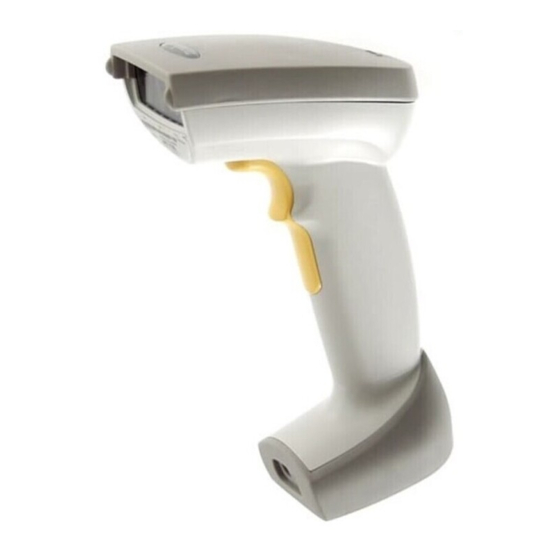
Symbol LS 4071 Quick Reference
Hide thumbs
Also See for LS 4071:
- Quick reference manual (61 pages) ,
- Product reference manual (168 pages)
Table of Contents
Advertisement
Quick Links
Advertisement
Table of Contents

Summary of Contents for Symbol LS 4071
- Page 1 RS 2200/3200 Series LS 4071 Scanner Quick Reference...
- Page 2 © 1997 SYMBOL TECHNOLOGIES, INC. All rights reserved. Symbol reserves the right to make changes to any product to improve reliability, function, or design. Symbol does not assume any product liability arising out of, or in connection with, the application or use of any product, circuit, or application described herein.
-
Page 3: Scanning Made Easy
Introduction The LS 4071 is a high performance scanner that lets you scan a bar code and transmit it to a base station up to 10 feet (3 meters) away, without a physical cable to limit your movement. Instead, the scanner communicates with the base station through a low power radio transmission. - Page 4 When you press the trigger, the scanning beam is energized for approximately 3.0 seconds (default). Scan Make sure the symbol you want to scan is within the scanning range. See the LS 4071 Product Reference Guide. Also, be certain the scanner is within range of the base station: 10 feet (3 meters).
-
Page 5: Scan The Entire Symbol
Scan the Entire Symbol • Your scan beam must cross every bar and space on the symbol. • The larger the symbol, the farther away you should hold the scanner. • Hold the scanner closer for symbols with bars that are close together. -
Page 6: Hold At An Angle
Hold at an angle Do not hold the scanner directly over the bar code. Laser light reflecting directly back into the scanner from the bar code is known as specular reflection. This strong light can “blind” the scanner and make decoding difficult. The area where specular reflection occurs is known as a “dead zone”. -
Page 7: What Does The Beep Mean
What If... If the scanner is not operating according to your needs, contact the technical person in charge of scanning. If there is no one in charge of scanning, call the Symbol Support Center at 1-800-653-5350. -
Page 8: Host Types
Host Types When using an RL475 system, select one of the bar codes below to communicate with an IBM 468X/9X host. Port 5B Port 9B Port 17 Note: To properly communicate with 468X/9X terminals, the driver corresponding to the port being used must be loaded and enabled when you are configuring your terminal system. - Page 9 Host Types RS-232C Host Types Three RS-232C hosts are set up with their own parameter default settings. Selecting the ICL, Fujitsu or Nixdorf RS-232C terminal sets the defaults listed on the following page. These defaults take precedence over Standard RS-232 defaults. So, if you’ve selected Fujitsu RS-232C, then select the Standard RS-232 defaults, the Fujitsu defaults still take precedence.
- Page 10 Host Types Parameter Standard FUJITSU NIXDORF Mode A/ Mode B Transmit Code ID Data Data as is Data/Suffix Data/Suffix Data/Suffix Transmission Format Suffix CR/LF Baud Rate 9600 9600 9600 9600 Parity None Even None Hardware None RTS/CTS None RTS/CTS Handshaking Option 3 Option 3 Software...
- Page 11 Host Types When using an RL474 system, select one of the bar codes below to communicate with an RS-232C host. STANDARD RS-232C ICL RS-232C NIXDORF RS-232C Mode A NIXDORF RS-232C Mode B FUJITSU RS-232C...
-
Page 12: Regulatory Information
Regulatory Information Scanner Labeling C A U T I O N ACHTUNG LASERSTRAHL LASERKLASSE 2 NICHT IN DEN STRAHL BLICKEN,. LUMIERE LASER NE PAS REGARDER DANS LE FAISCEAU APPARIEL A LASER DE CLASSE 2. CAUTION - LASER LIGHT. DO NOT STARE INTO BEAM. - Page 13 Regulatory Information Class I Symbol U.S. Federal (FDA)/IEC825/EN60825 Class 1 laser products use low power visible or IR lasers. Class 1 laser devices are not considered to be hazardous when used for their intended purpose. To comply with U. S. Federal and...
- Page 14 Regulatory Information In accordance with Clause 5, IEC 0825 and EN60825, the follow- ing information is provided to the user: ENGLISH CLASS 1 CLASS 1 LASER PRODUCT CLASS 2 LASER LIGHT DO NOT STARE INTO BEAM CLASS 2 LASER PRODUCT DANISH KLASSE 1 KLASSE 1 LASERPRODUKT...
- Page 15 Regulatory Information GERMAN KLASSE 1 LASERPRODUKT DER KLASSE 1 KLASSE 2 LASERSTRAHLEN NICHT DIREKT IN DEN LASERSTRAHL SCHAUEN LASERPRODUKT DER KLASSE 2 HEBREW ITALIAN CLASSE 1 PRODOTTO AL LASER DI CLASSE 1 CLASSE 2 LUCE LASER NON FISSARE IL RAGGIOPRODOTTO AL LASER DI CLASSE 2 NORWEGIAN KLASSE 1 LASERPRODUKT, KLASSE 1...
-
Page 16: Warranty Information
This warranty is limited to repair or replacement at Symbol’s option, with reasonable promptness after being returned to Symbol by a carrier selected and paid for by the customer. These provisions do not prolong the original warranty term for any product which has been repaired or replaced by Symbol.










Need help?
Do you have a question about the LS 4071 and is the answer not in the manual?
Questions and answers